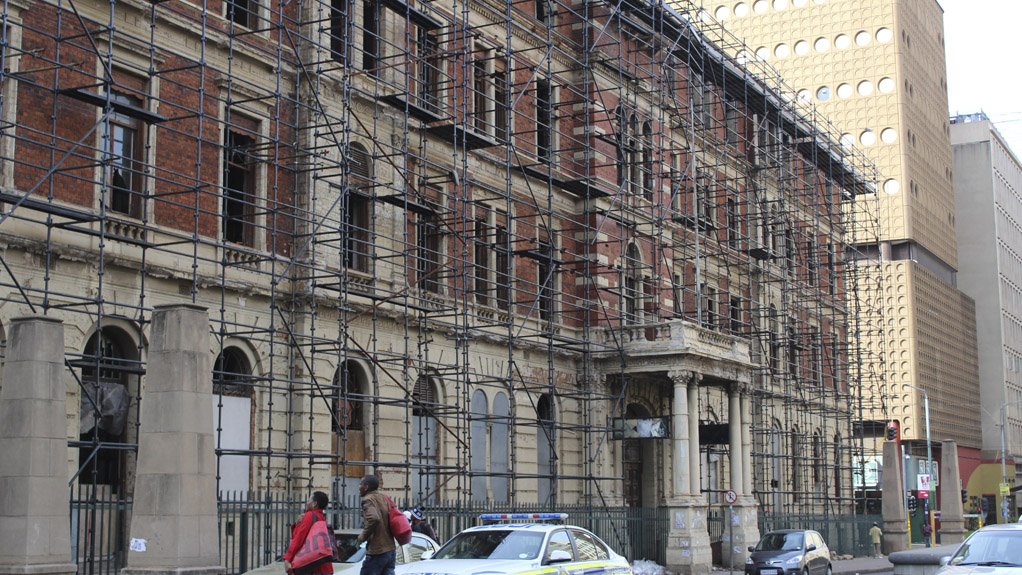In a R60-million renovation project, the former post office on Rissik street is being restored to its former glory as one of Johannesburg’s standout heritage sites.
During a media tour hosted by the Johannesburg Property Company (JPC) last month, Johannesburg-based Paradigm Architects principal architect James Wylie explained that the building operated as a post office from 1897 until its closure in the 1990s.
Subsequent to its closing down, the building caught fire twice, in 2008 and 2009, resulting in a significant part of it being destroyed, particularly the inside of the building.
The budget allocation will be used over the next three years, primarily for the restoration of the external façades, particularly the northern, southern and western façades, the clock tower and the roof.
“Unfortunately, after the fire, so little of the rest of the building was left to be preserved, so we are focusing on those four aspects,” Wylie said during the tour.
Temporary closures are being put on the windows and doors around the building, with the clock tower also being sealed off and roofed over to prevent further damage. Work is also being done on the roof that covers the main hall of the building, which entails repairing the box gutters and trusses of the roof.
Completed work includes the installation of steel structural frames in the two main halls of the building, as well as the construction of new foundations and columns in the basement, which will be used to support additional floors in future developments.
Meanwhile, Wylie explained that the post office was originally built with another building touching the eastern façade of the post office, which was destroyed, leaving the eastern façade of the building blank.
Across the eastern façade is a park, which Wylie noted did not respond to the post office. “One of the major ideas we have is to open the post office into the park by replacing the eastern wall with a glass façade, which will lead into a lobby that will feed into the two main halls of the post office. By the time we are done, we are hoping that the connection between the Rissik Street post office and the park will be done.”
JPC project manager Leonard Visagie noted that there had not been an agreement regarding the long-term use of the building, but that the JPC was considering making the building available for interim use over a period of about three years.
Wylie highlighted that the two main halls of the building had vastly differing characteristics, with the larger main postal hall being envisaged as a location for banquets and parties, and the multistorey area possibly being used for staging product launches or hosting small-scale concerts.
The rest of the building will be used to serve the two main halls, which Wylie noted would include ablution facilities and possibly warming kitchens.
“During the interim phase, we will not be looking at any developments for the upper floors. The trick so far is to design what we have done in a way that the building remains as flexible as possible, purely because we still do not know what the final use of the building will be,” he said.
The tour also included the award-winning Soweto Theatre, where another heritage site, the Jabulani Amphitheatre, is also being restored. In 1985, Zindzi Mandela famously read her father Nelson Mandela’s letter to then South African President PW Botha at the amphitheatre.
The amphitheatre was built in 1952 and could originally seat 15 000 people; however, JPC project manager Betsy Malope explained that, owing to degradation, the steel framework from the seats had been reused by local artists to create sculptures that narrate the history and major moments of the amphitheatre.
“What we are trying to do is preserve the history of the amphitheatre and, during the design phase of the project, we tried to consider its historical use.” she added.
The original brickwork of the amphitheatre will remain, but now includes allocated seating for people with disabilities and areas for wheelchairs.
Access to the amphitheatre has mostly been retained through the pre-existing stair system. A bridge will also be constructed over the main stage, enabling people to move freely from one side of the area to the other.
Edited by: Martin Zhuwakinyu
Creamer Media Senior Deputy Editor
EMAIL THIS ARTICLE SAVE THIS ARTICLE
ARTICLE ENQUIRY
To subscribe email subscriptions@creamermedia.co.za or click here
To advertise email advertising@creamermedia.co.za or click here













